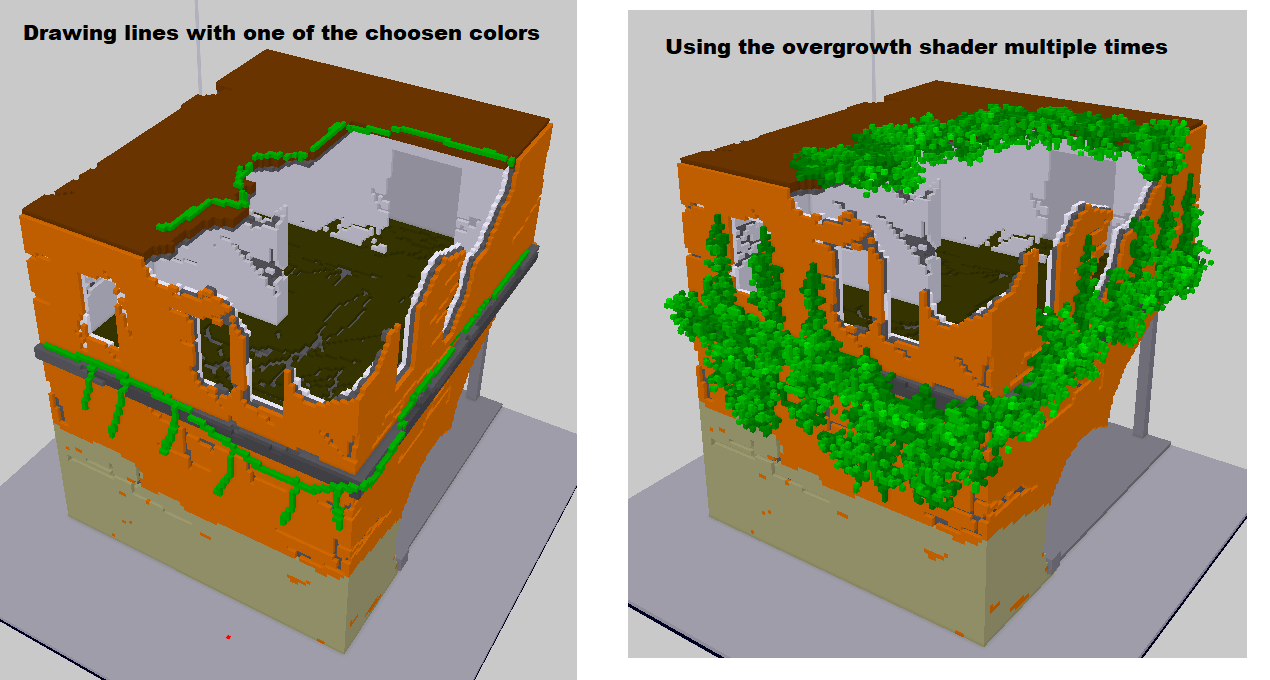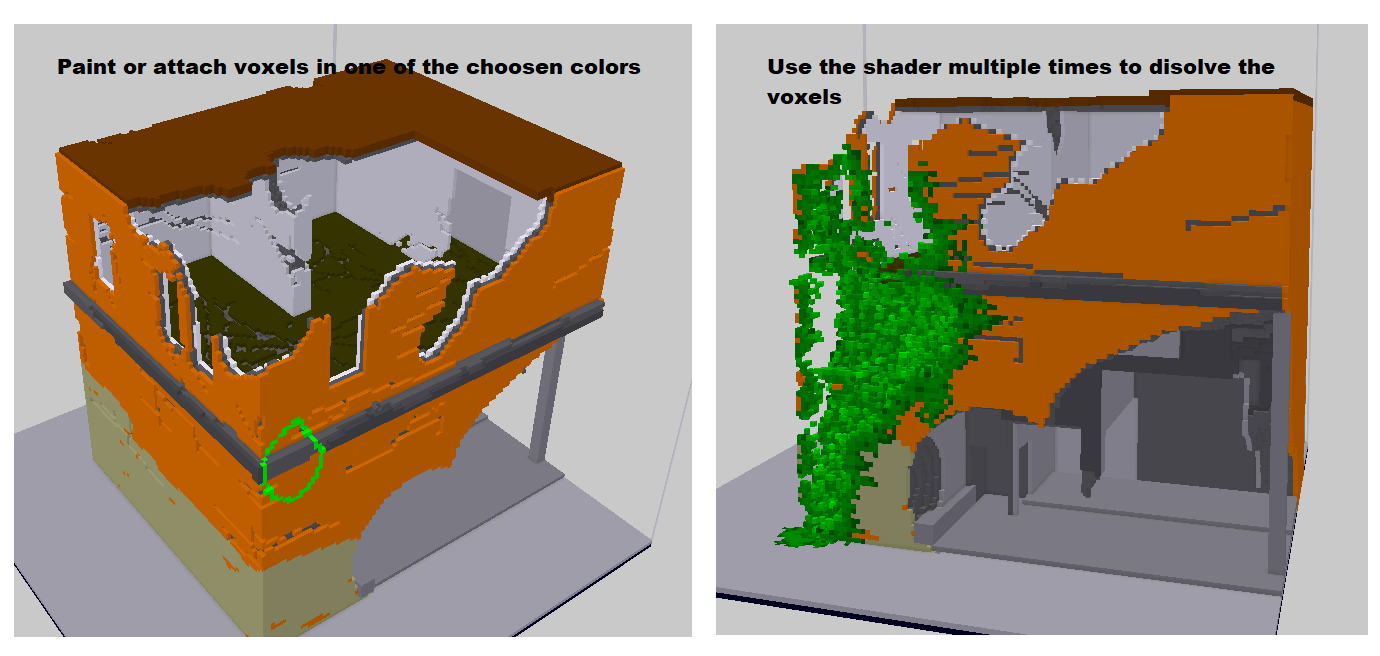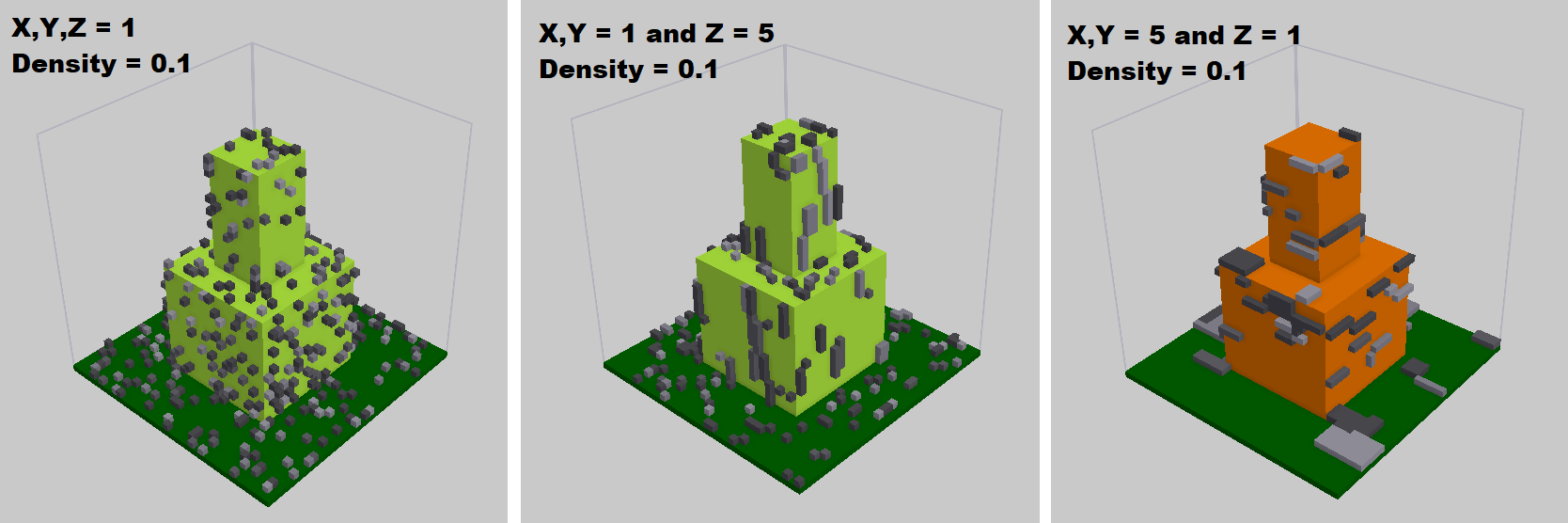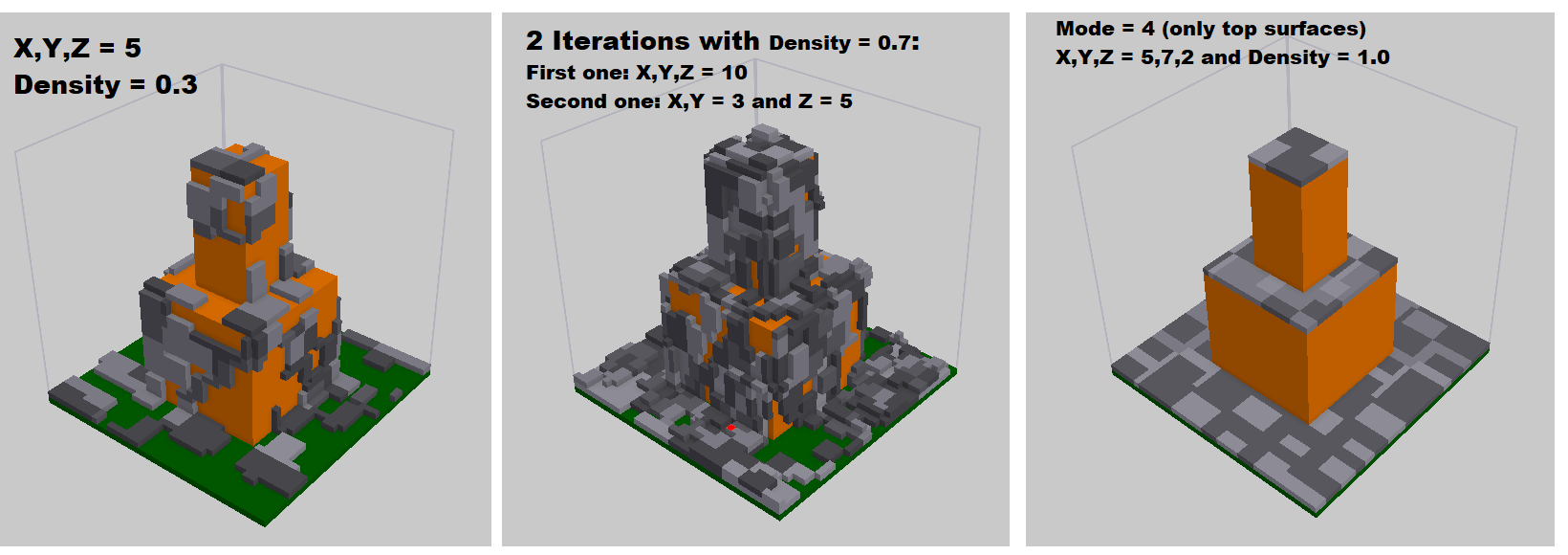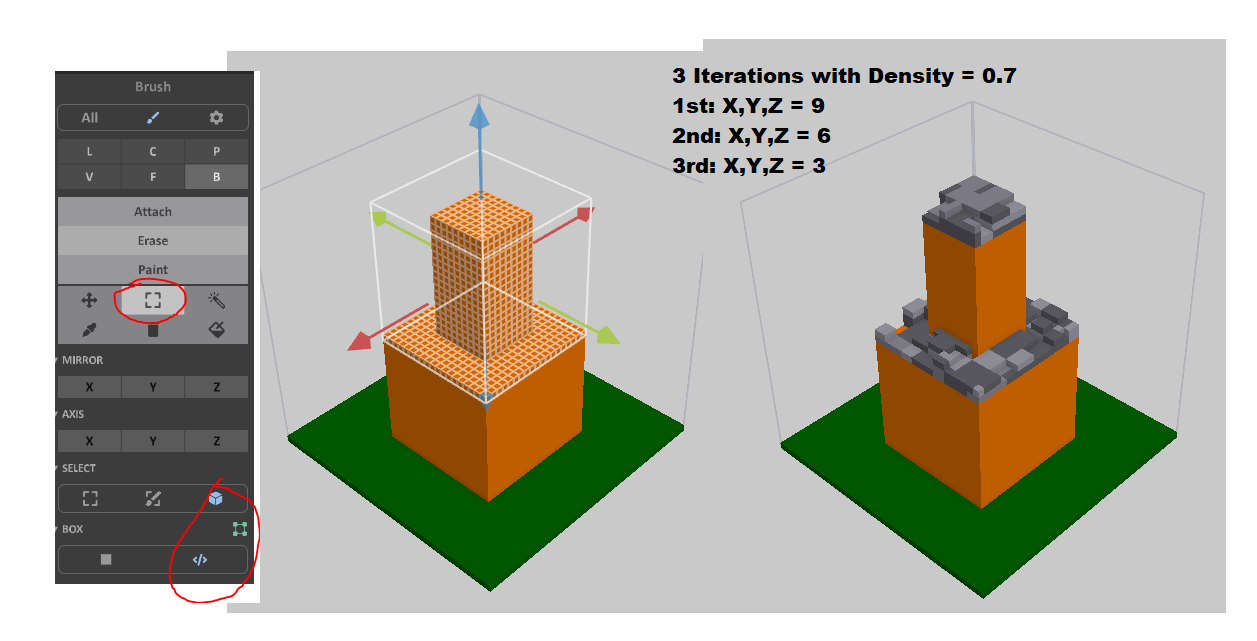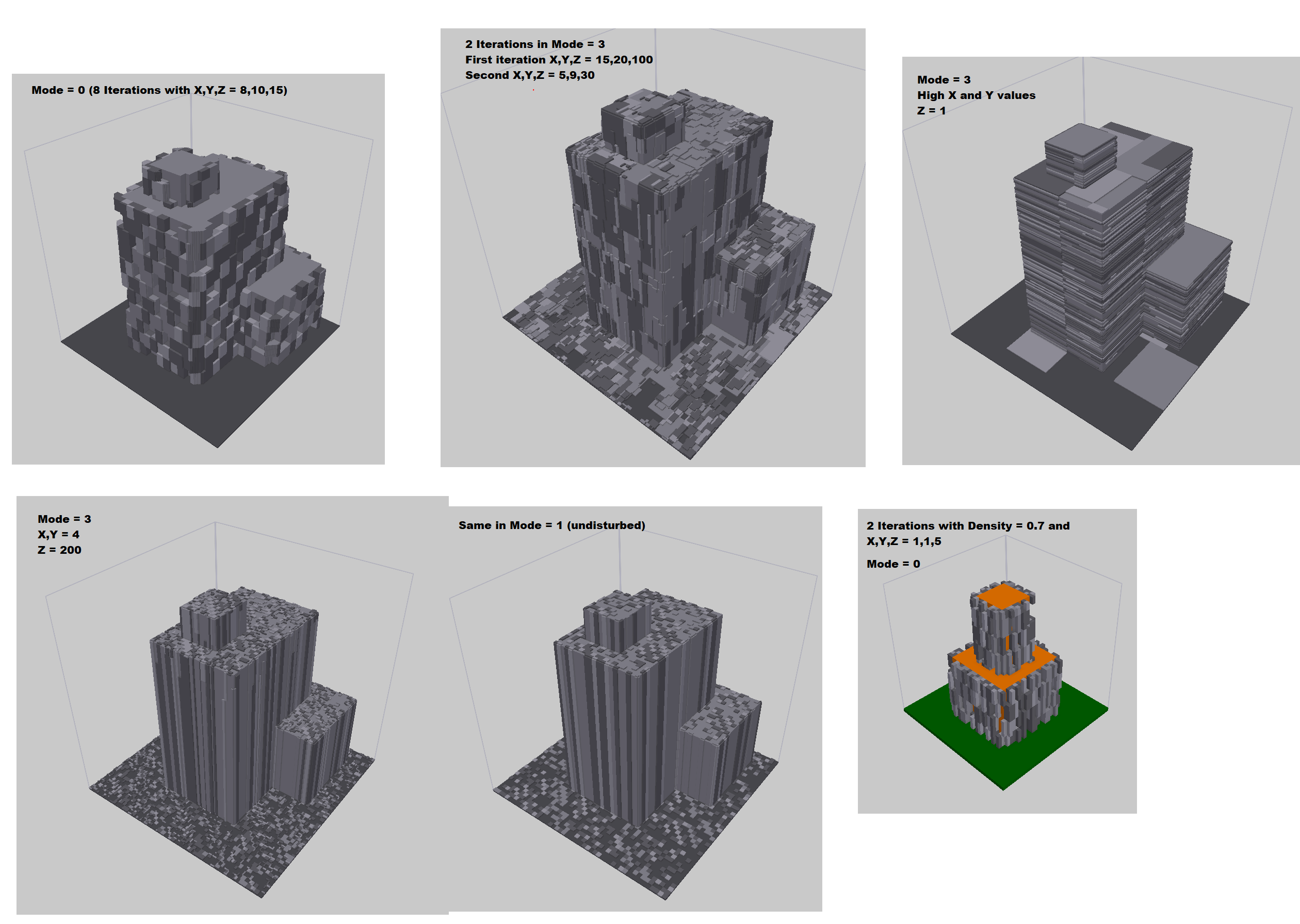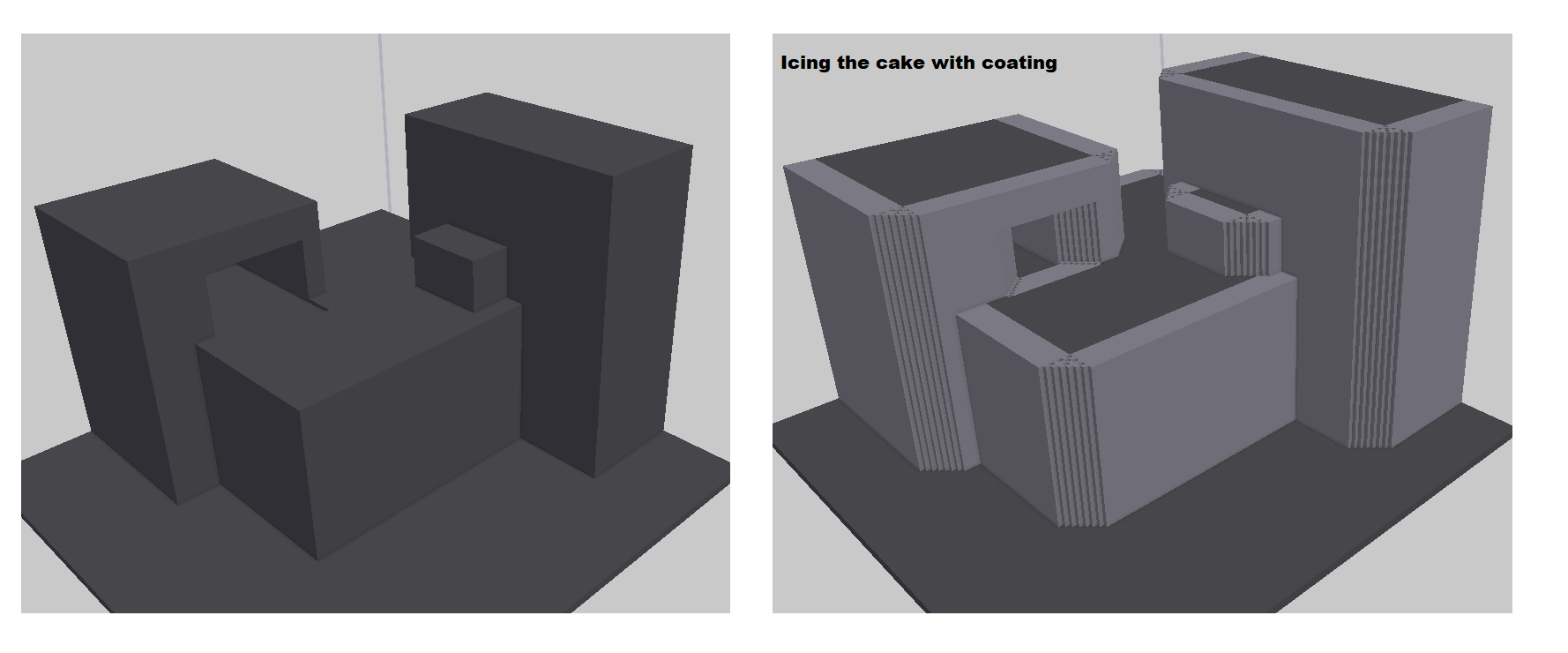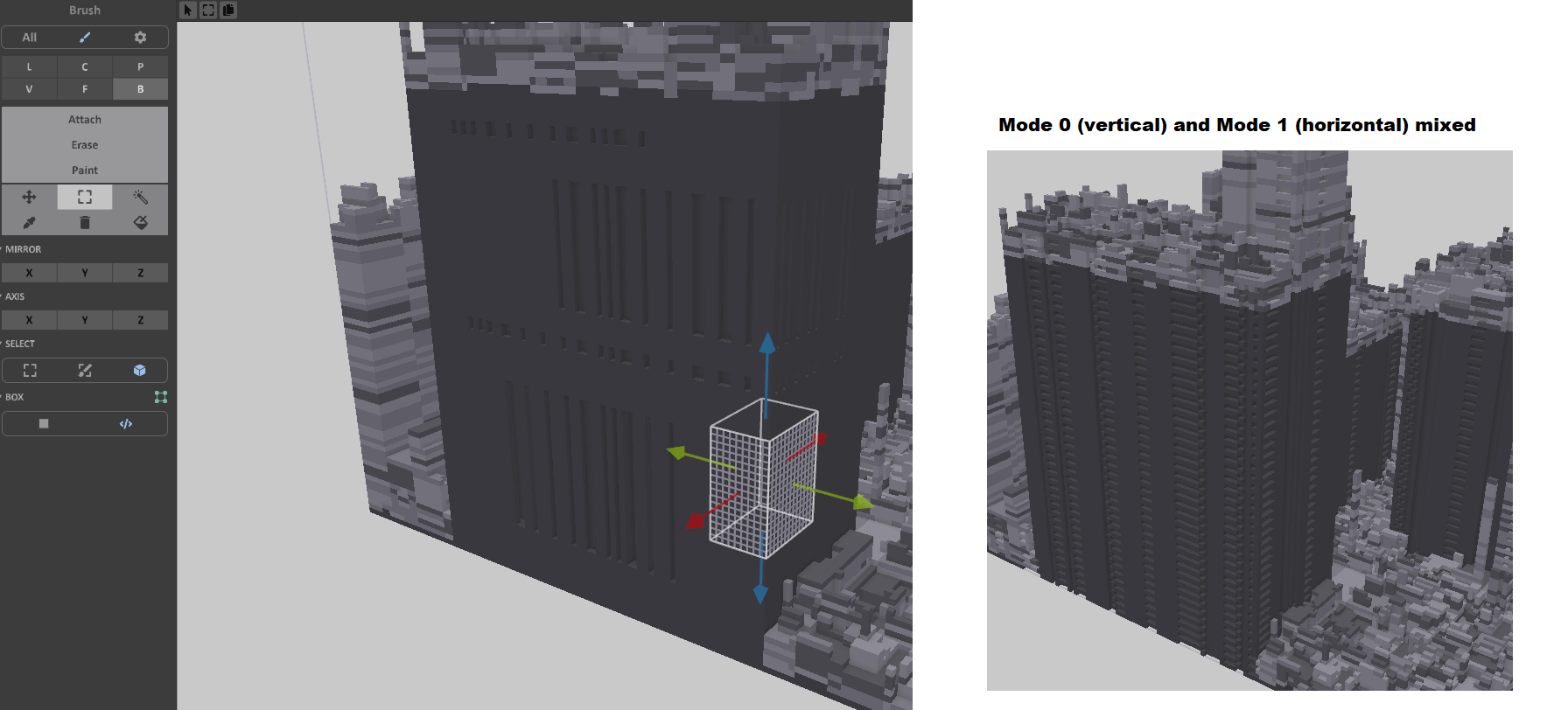Repository for magica voxel shaders.
Install the shader by copying the file from the shader directory into the shader directory of your MagicaVoxel installation.
After installing the shaders (see Installation above) you should see them in the shader menu.
Use them according to the description below and try mixing them up for cool results.
This shader lets you create a mossy or leafy plant or foam (you choose the color set) on your voxel art.
There are 5 parameters right now:
| Parameter | Range | Description |
|---|---|---|
| Max Volume | 1 to 100 | The growth width or thickness of the plants. 3 to 5 looks quite natural. 1 is interesting and higher values might cause MagicaVoxel to crash due to high computational effort. |
| Random Seed | 0 to 1.000.000 | Using the shader on the same scene will always yield the exact same result as long as you don't change this value. Play with this to yield different patterns on the same scene. |
| Growth Density | 0.000 to 1.000 | 1 will look like a very thick carpet of plants while lower values will look more natural. |
| Color A | A color index (0 to 255) | You may paint the different layers of your plant in different colors. Color A will be the index of the color of the lowest layer (roots) of the plant. |
| Color B | A color index (0 to 255) | You may paint the different layers of your plant in different colors. Color B will be the index of the color of the highest tip (leaves) of the plant. |
Color A and B define a range of colors. If you set them to the same index, only this color is used.
After setting your values as you like, you need to place some voxels of any colors in range of the Color A and Color B parameter you have choosen. The color range is defined by lowest to highest index (Regarding the color A and color B parameter). All colors within this range are the seed colors of your plants. This means, these colors will 'grow' if you hit the play button on the shader.
Then hit the play button on the shader a few times to watch them grow step by step.
The mossy plant created should have a color gradient from lowest color index outside (at the leaves) to highest color index at the inside (near the roots).
You can also use this command in the console to execute the shader multiple times:
xs -n 20 overgrowth 4 123.0 0.3 232 226
20 is the number of iterations (e.g. the number of times you would press the play button). The parameter after overgrowth are the parameter defined above in the same order.
You can also use marquee select with the box select and voxel shader option to apply the shader only to a part of your scene.
I tested the shader with objects of max size 256 x 256 x 256. It can get really slow on this size. Also the Max Volume parameter should be kept under 8. I encountered some crashes when using 8 or higher.
Caution! This shader will eat your voxels :). Once you place a drop of color (you choose the color set) and run the shader it will dissolve your voxels like acid. It's the inverse of the overgrowth shader
| Parameter | Range | Description |
|---|---|---|
| Max Volume | 1 to 100 | The higher this value, the deeper the shader will eat into the voxels with each step. Higher values might cause MagicaVoxel to crash due to high computational effort. |
| Random Seed | 0 to 1.000.000 | Using the shader on the same scene will always yield the exact same result as long as you don't change this value. Play with this to yield different patterns on the same scene. |
| Growth Density | 0.000 to 1.000 | This defines the probability that a voxel is removed in one step. The higher the value the more aggressive the corrosion. |
| Color A | A color index (0 to 255) | Defines one side of a range of colors, that will be used as the acid to corrode other voxels. |
| Color B | A color index (0 to 255) | Defines the other side of a range of colors, that will be used as the acid to corrode other voxels. |
Color A and B define a range of colors. If you set them to the same index, only this color is used. The color range is always from lowest to highest value regardless which one is A or B. You may use any of the colors within this range (including A and B) to start the corrosion on voxels with that color. E.g.: if you choose a range of red colors, any of these red colors will start to corrode.
This shader will grow a patina on your voxels. It won't create new voxels, just change the color. It uses the same pattern as the corrosion shader and the overgrowth shader.
| Parameter | Range | Description |
|---|---|---|
| Max Volume | 1 to 100 | This influences the color placement pattern of the patina. Just play around with it. Higher values might cause MagicaVoxel to crash due to high computational effort. |
| Random Seed | 0 to 1.000.000 | Using the shader on the same scene will always yield the exact same result as long as you don't change this value. Play with this to yield different patterns on the same scene. |
| Growth Density | 0.000 to 1.000 | This defines the probability that a voxel is painted in one step. The higher the value the more aggressive the spread of the patina. |
| Color A | A color index (0 to 255) | Defines one side of a range of colors, that will be used as the acid to corrode other voxels. |
| Color B | A color index (0 to 255) | Defines the other side of a range of colors, that will be used as the acid to corrode other voxels. |
Color A and B define a range of colors. If you set them to the same index, only this color is used. The color range is always from lowest to highest value regardless which one is A or B. You may use any of the colors within this range (including A and B) to start the spread of the patina. E.g.: if you choose a range of red colors, any of these red colors will start to spread. Also, if choosing a color range, the outer rim of the patina will be color A while the center will be more color B.
This one is very versatile!
There are the current maximum of 8 parametes for you to adjust this shader.
| Parameter | Description |
|---|---|
| Mode | One of the following.
|
| Random Seed | Using the shader on the same scene will always yield the exact same result as long as you don't change this value. Play with this to yield different patterns on the same scene. |
| Density | Between 0 and 1 |
| Color A | The index of the first color you want to use for your plates. Colors are distributed randomly between plates. |
| Color B | If different from Color A, it defines the last index of the color range given by all colors between A and B (inclusive). Colors are distributed randomly between plates. |
| xWidth | The thickness of the plates in x direction. |
| yWidth | The thickness of the plates in y direction. |
| zWidth | The thickness of the plates in z direction. |
The last 3 properties, together with the density define the look and outcome of the shader massively. Try playing around with them. Use very high xWidth and yWidth with a zWidth of 1 or change density during iterations to create interesting patterns.
A bit like the Plates shader but it draws multiple layers of plates and only on Floors.
| Parameter | Description |
|---|---|
| Random Seed | Using the shader on the same scene will always yield the exact same result as long as you don't change this value. Play with this to yield different patterns on the same scene. |
| Density | Between 0 and 1 |
| Color A | The index of the first color you want to use for your plates. Colors are distributed randomly between plates. |
| Color B | If different from Color A, both indices defines the range of all colors between A and B (inclusive). The range always starts at the lower index. Colors are distributed randomly between plates. |
| xWidth | A modifier to the thickness of the plates in x direction. It's not the exact width of the plates in the end. |
| yWidth | A modifier to the thickness of the plates in y direction. It's not the exact width of the plates in the end. |
Very simple shader. It adds one vertex to the outside of every existing vertex on every wall in the selection. The color of the coat is always the currently selected color. It simply adds layers to existing wall vertices.
This one cuts out vertical (mode 0) or horizontal (mode 1) lines from selected walls.
